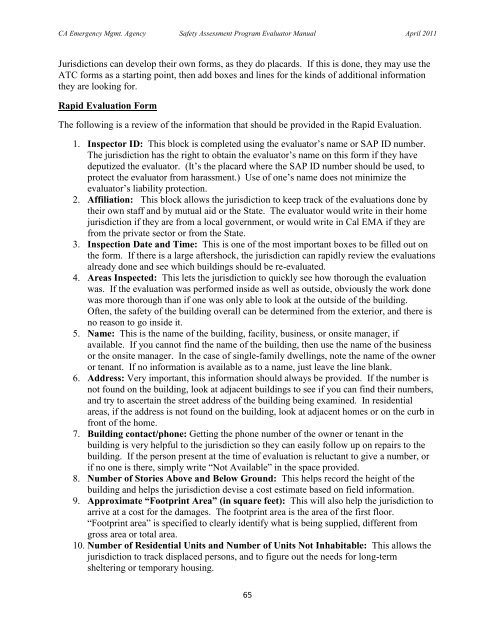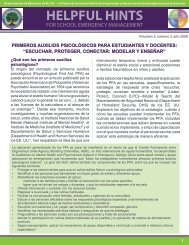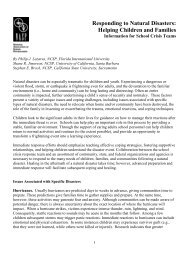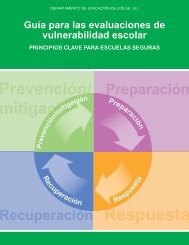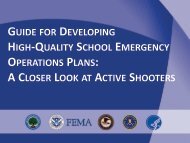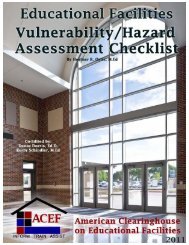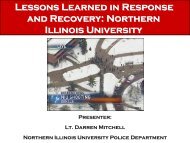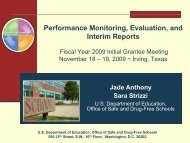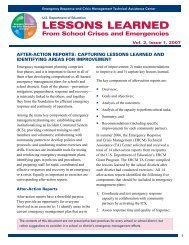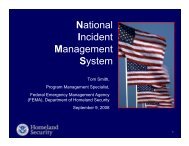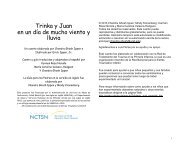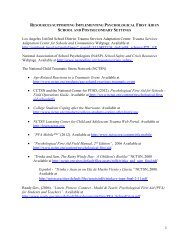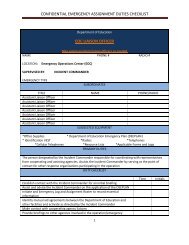Safety Assessment Program Evaluator Student Manual
Safety Assessment Program Evaluator Student Manual
Safety Assessment Program Evaluator Student Manual
Create successful ePaper yourself
Turn your PDF publications into a flip-book with our unique Google optimized e-Paper software.
CA Emergency Mgmt. Agency <strong>Safety</strong> <strong>Assessment</strong> <strong>Program</strong> <strong>Evaluator</strong> <strong>Manual</strong> April 2011Jurisdictions can develop their own forms, as they do placards. If this is done, they may use theATC forms as a starting point, then add boxes and lines for the kinds of additional informationthey are looking for.Rapid Evaluation FormThe following is a review of the information that should be provided in the Rapid Evaluation.1. Inspector ID: This block is completed using the evaluator‟s name or SAP ID number.The jurisdiction has the right to obtain the evaluator‟s name on this form if they havedeputized the evaluator. (It‟s the placard where the SAP ID number should be used, toprotect the evaluator from harassment.) Use of one‟s name does not minimize theevaluator‟s liability protection.2. Affiliation: This block allows the jurisdiction to keep track of the evaluations done bytheir own staff and by mutual aid or the State. The evaluator would write in their homejurisdiction if they are from a local government, or would write in Cal EMA if they arefrom the private sector or from the State.3. Inspection Date and Time: This is one of the most important boxes to be filled out onthe form. If there is a large aftershock, the jurisdiction can rapidly review the evaluationsalready done and see which buildings should be re-evaluated.4. Areas Inspected: This lets the jurisdiction to quickly see how thorough the evaluationwas. If the evaluation was performed inside as well as outside, obviously the work donewas more thorough than if one was only able to look at the outside of the building.Often, the safety of the building overall can be determined from the exterior, and there isno reason to go inside it.5. Name: This is the name of the building, facility, business, or onsite manager, ifavailable. If you cannot find the name of the building, then use the name of the businessor the onsite manager. In the case of single-family dwellings, note the name of the owneror tenant. If no information is available as to a name, just leave the line blank.6. Address: Very important, this information should always be provided. If the number isnot found on the building, look at adjacent buildings to see if you can find their numbers,and try to ascertain the street address of the building being examined. In residentialareas, if the address is not found on the building, look at adjacent homes or on the curb infront of the home.7. Building contact/phone: Getting the phone number of the owner or tenant in thebuilding is very helpful to the jurisdiction so they can easily follow up on repairs to thebuilding. If the person present at the time of evaluation is reluctant to give a number, orif no one is there, simply write “Not Available” in the space provided.8. Number of Stories Above and Below Ground: This helps record the height of thebuilding and helps the jurisdiction devise a cost estimate based on field information.9. Approximate “Footprint Area” (in square feet): This will also help the jurisdiction toarrive at a cost for the damages. The footprint area is the area of the first floor.“Footprint area” is specified to clearly identify what is being supplied, different fromgross area or total area.10. Number of Residential Units and Number of Units Not Inhabitable: This allows thejurisdiction to track displaced persons, and to figure out the needs for long-termsheltering or temporary housing.65


